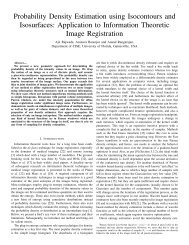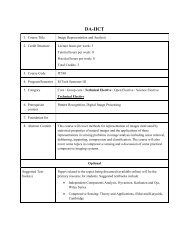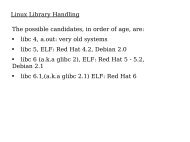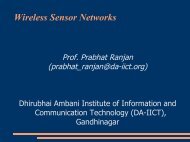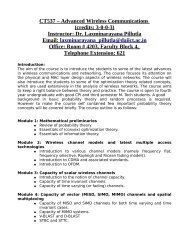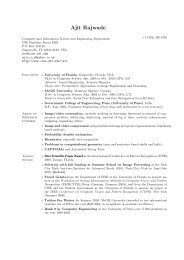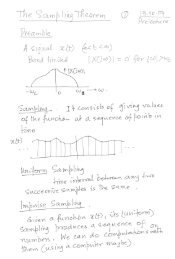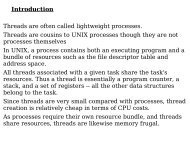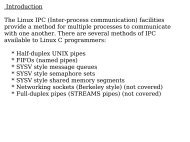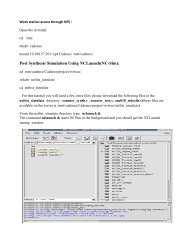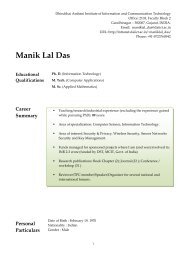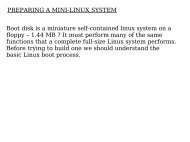Antenna - DAIICT Intranet
Antenna - DAIICT Intranet
Antenna - DAIICT Intranet
Create successful ePaper yourself
Turn your PDF publications into a flip-book with our unique Google optimized e-Paper software.
<strong>Antenna</strong><br />
Prof. Prabhat Ranjan
Material Based on<br />
● APPLICATION NOTE AN-00500 - <strong>Antenna</strong>s:<br />
Design, Application, and Performance<br />
(www.linx.com)
Transmission Line<br />
● A transmission line is any medium whereby<br />
contained RF energy is transferred from one<br />
place to another
● The diameter and spacing of the conductors<br />
as well as the dielectric constant of the<br />
materials surrounding and separating the<br />
conductors plays a critical role in determining<br />
the transmission line’ s properties<br />
● One of the most important of these properties<br />
is called characteristic impedance - value in<br />
ohms at which the voltage-to-current ratio is<br />
constant along the transmission line<br />
● Characteristic impedance - 50 ohms common
● In order to achieve the maximum transfer of<br />
RF energy from the transmission line into the<br />
antenna, the characteristic impedance of the<br />
line and the antenna at frequency should be<br />
as close as possiblem – matched<br />
● When a transmission line is terminated into an<br />
antenna that differs from its characteristic<br />
impedance, a mismatch will exist<br />
● -> all of the RF energy is not transferred from<br />
the transmission line into the antenna
● Energy that cannot be transferred into the<br />
antenna is reflected back on the transmission<br />
line<br />
● Since this energy is not reflected into space, it<br />
represents a loss<br />
● Ratio between the forward wave and the<br />
reflected wave is known as the Standing<br />
Wave Ratio (SWR)<br />
● Ratio between the sum of the forward voltage<br />
and the reflected voltage is commonly called<br />
the Voltage Standing Wave Ratio (VSWR)
What is an <strong>Antenna</strong><br />
● A RF antenna is defined as a component that<br />
facilitates the transfer of a guided wave into,<br />
and the reception from, free space<br />
● In function, the antenna is essentially a<br />
transducer that converts alternating currents<br />
into electromagnetic fields or vice versa<br />
● The physical components that make up an<br />
antenna’ s structure are called elements<br />
● From a coat hanger to a tuned Yagi, there are<br />
literally hundreds of antenna styles and<br />
variations that may be employed
● Two fundamental types of antennas, which,<br />
with reference to a specific three dimensional<br />
(usually horizontal or vertical) plane are:<br />
– either Omni-directional (radiates equally in all<br />
directions) or<br />
– Directional (radiates more in one direction than in<br />
the other)<br />
● All antennas radiate some energy in all<br />
directions in free space but careful<br />
construction results in substantial<br />
transmission of energy in certain directions<br />
and negligible energy radiated in other
Omni-directional<br />
● The basic antenna is known as an “o mni-<br />
directional”<br />
● Omni antennas radiate their RF energy in all<br />
directions,essentially outwards in a threedimensional<br />
spherical pattern<br />
● Omni antennas usually resemble vertical rods<br />
but can come in other shapes as well<br />
● Some have horizontal rods of the same length<br />
placed at their base to increase their<br />
performance/distance - “ ground planes”
● Other antenna types include the “d ipole” ,<br />
where a section of wire, one-half the<br />
wavelength, is positioned either horizontally or<br />
vertically in the air to transmit signals.<br />
● Dipoles emit their signals in more of a twodimensional<br />
semi-circular or “ doughnut”<br />
pattern, the key being both the transmitter and<br />
receiver’ s antennas must be aligned the same<br />
(horizontally or vertically)
● Dipoles do not require a ground-plane and are<br />
considered “b i-directional,” in that their signals<br />
travel in two opposite directions, depending<br />
on how the antenna is oriented
Yagi <strong>Antenna</strong><br />
● By adding additional conducting rods or coils<br />
(called elements) and varying their length,<br />
spacing, and orientation (or changing the<br />
direction of the antenna beam), an antenna<br />
with specific desired properties can be<br />
created, such as a Yagi-Uda <strong>Antenna</strong> (often<br />
abbreviated to "Yagi")
● A Yagi antenna is basically a standard onehalf<br />
wavelength antenna, but with additional<br />
“ elements” placed in front of it to focus the<br />
energy for transmission in one direction<br />
● The “ reflector” and “ director” elements are just<br />
similar-sized resonators spaced appropriately<br />
to increase the strength and narrow the<br />
direction of the signal prior to transmission<br />
● Again, the key to successfully using Yagi<br />
antennas is the correct orientation and<br />
alignment of the transmitting/receiving<br />
antennas.
THE TRANSMITTER ANTENNA<br />
● Allows RF energy to be efficiently radiated<br />
from the output stage into free space<br />
● In many modular and discrete transmitter<br />
designs the transmitter’ s output power is<br />
purposefully set higher than the legal limit<br />
● This allows a designer to utilize an inefficient<br />
antenna to achieve size, cost, or cosmetic<br />
objectives and still radiate the maximum<br />
allowed output power<br />
● However in portableembedded devices power<br />
consumed has to be less also
THE RECEIVER ANTENNA<br />
● The receiving antenna intercepts the<br />
electromagnetic waves radiated from the<br />
transmitting antenna<br />
● When these waves impinge upon the<br />
receiving antenna, they induce a small voltage<br />
in it<br />
● This voltage causes a weak current to flow,<br />
which contains the same frequency as the<br />
original current in the transmitting antenna
● Should capture as much of the intended<br />
signal as possible and as little as possible of<br />
other off-frequency signals<br />
● Its maximum performance should be at the<br />
frequency or in the band for which the<br />
receiver was designed<br />
● The efficiency of the receiver’ s antenna is<br />
critical to maximizing range performance.<br />
● Unlike the transmitter antenna, where legal<br />
operation may mandate a reduction in<br />
efficiency, the receiver’ s antenna should be<br />
optimized as much as is practical
<strong>Antenna</strong> Gain<br />
● The term gain refers to the antenna’ s effective<br />
radiated power compared to the effective<br />
radiated power of some reference antenna<br />
● When the isotopic model is used, the gain will<br />
be stated in dBi (meaning gain in dB over<br />
isotopic)<br />
● When gain is being compared to a standard<br />
dipole, the rating will be stated in dBd<br />
(meaning gain over dipole)
<strong>Antenna</strong> Gain ...<br />
● The generally accepted variation between<br />
isotopic and a standard dipole is 2.2dB<br />
● Thus, an antenna rated as having 15dBi of<br />
gain would indicate the antenna had 15dB of<br />
gain over isotopic or 12.8dB of gain as<br />
compared to a standard single-element dipole
● Gain is commonly misinterpreted as an<br />
increase in output power above unity<br />
● Of course, this is impossible since the<br />
radiated power would be greater than the<br />
original power introduced to the antenna<br />
●
● In the same way, an antenna that focuses RF<br />
energy into a narrow beam can be said to<br />
have gain (at the point of focus) over an<br />
antenna that radiates equally in all directions<br />
● In other words, the higher an antenna’ s gain<br />
the narrower the antenna’ s pattern and the<br />
better its point performance will be<br />
●
Multipath Effect
● Multipath fading is a form of fading caused by<br />
signals arriving at the receiving antenna in<br />
different phases<br />
● This effect is due to the fact that a signal may<br />
travel many different paths before arriving at<br />
the antenna<br />
● Some portions of the original signal may travel<br />
to the receiver’ s antenna via a direct free<br />
space path
● Others, which have been reflected, travel<br />
longer paths before arrival<br />
● The longer path taken by the reflected waves<br />
will slightly delay their arrival time from that of<br />
the free space wave<br />
● This creates an out-of-phase relationship<br />
between the two signals<br />
● The resulting voltage imposed on the<br />
receiving antenna will vary based on the<br />
phase relationship of all signals arriving at the<br />
antenna
● While this effect is environmental and not<br />
related directly to the antenna, it is still<br />
important to understand the role multipath<br />
may play in theoretical vs. realized antenna<br />
performance
POPULAR ANTENNA STYLES<br />
● Whip <strong>Antenna</strong>
● A whip-style antenna provides exceptional<br />
performance and stability<br />
● A straight whip has a wide bandwidth and is<br />
easily designed and integrated<br />
● Many designers opt for the reliable<br />
performance and cosmetic appeal of<br />
Professionally made antennas<br />
● These “ off-the-shelf” whip designs are<br />
generally made from a wire or cable<br />
encapsulated in a rubber or plastic housing
● A whip can also be made by cutting a piece of<br />
wire or rod to the appropriate length<br />
● Since a full-wave whip is generally quite long<br />
and its impedance high, most whips are either<br />
a ¼ or ½ wave
Helical Style<br />
● A helical element is a wire coil usually wound<br />
from steel, copper, or brass<br />
● By winding the element its overall physical<br />
length can be greatly reduced<br />
● The element may be enclosed inside the<br />
antenna housing or exposed for internal<br />
mounting<br />
● A helical antenna significantly reduces the<br />
physical size of the antenna, however, this<br />
reduction is not without a price
Helical Style<br />
● Because a helical has a high Q factor, its<br />
bandwidth is very narrow and the spacing of<br />
the coils has a pronounced effect on antenna<br />
performance<br />
● The antenna is prone to rapid detuning<br />
especially in proximity to objects<br />
● A well designed helical can achieve excellent<br />
performance while maintaining a compact size
Loop Trace Style<br />
● This style is popular in low-cost applications<br />
since it can be easily concealed and adds little<br />
to overall product cost<br />
● Element generally printed directly onto the<br />
PCB and can be made self-resonant or<br />
externally resonated with discrete comp<br />
● The actual layout is usually product specific<br />
● Despite its cost advantages, PCB antenna<br />
styles are generally inefficient and useful only<br />
for short-range applications
PCB mount antennas<br />
● Several low-cost planar and chip antenna<br />
alternatives to the often - problematic “ printed”<br />
antenna<br />
● These tiny antennas mount directly to a<br />
product’ s PCB and provide excellent<br />
performance in light of their compact size<br />
● Usually 70% efficient compared to Whip<br />
antenna
Loop Trace Style<br />
● This style is popular in low-cost applications<br />
since it can be easily concealed and adds little<br />
to overall product cost<br />
● The element is generally printed directly onto<br />
the product’ s PCB and can be made selfresonant<br />
or externally resonated with discrete<br />
components<br />
● The actual layout is usually product specific<br />
● Despite its cost advantages, PCB antenna<br />
styles are generally inefficient and useful only<br />
for short-range applications. A loop can be



